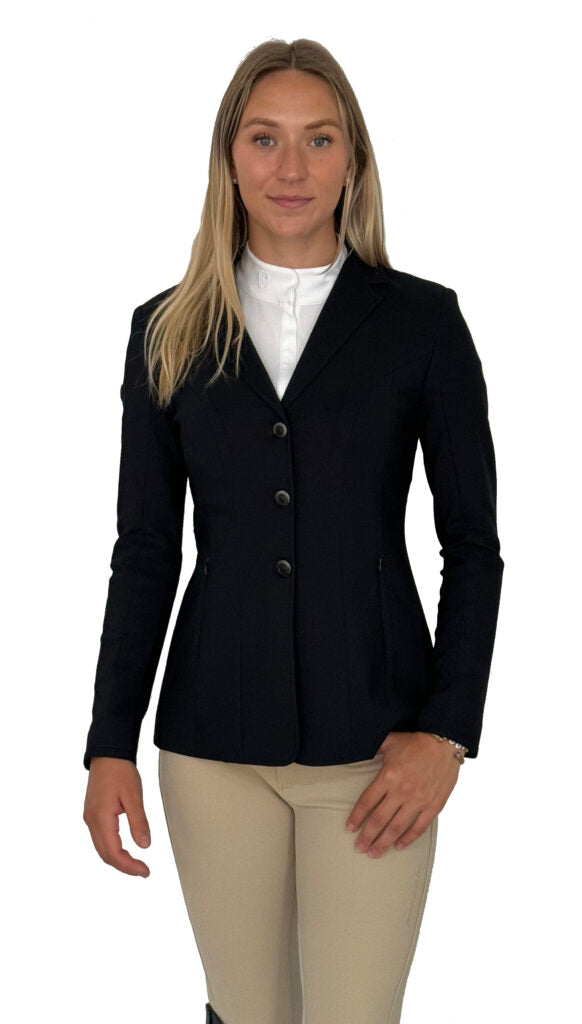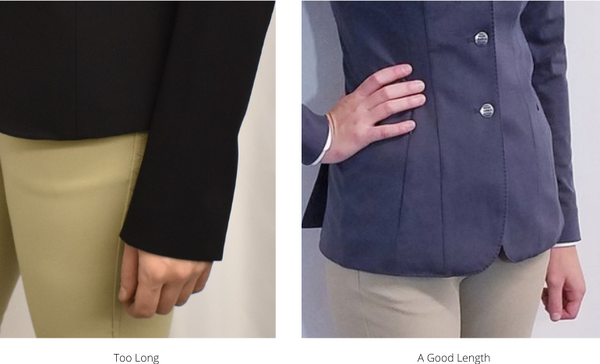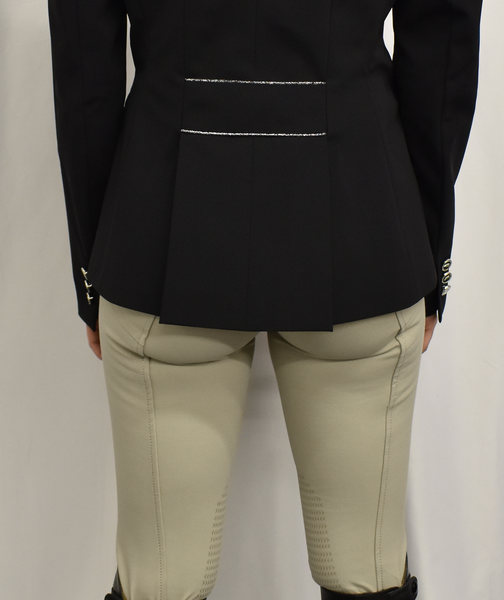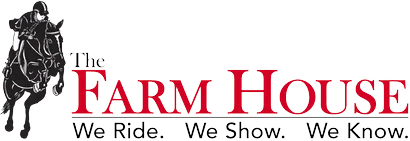
How to Find Your Perfect Equestrian Show Coat (Style + Fit Guide)
Michelle DrumWhether tackling a jumping course or commanding attention in the show ring, the right show coat can elevate your performance and presence. If you’re in the market for your first show coat, you’re starting in the right place. In this guide, we’ll explore show coat styles, fit, and sizing so you can find the perfect show coat for your next equestrian competition.
What is a show coat?
An equestrian show coat is a tailored jacket worn by riders during horse shows and competitions. It is designed to provide a polished and professional appearance while riding. Show coats are characterized by their tailored fit, three- or four-button closure, and vented back panels. Show coats are required for formal equestrian competitions to maintain tradition and presentation.
The phrases “show coat” and “show jacket” are used interchangeably in the equestrian industry. Show coats are often made from high-tech synthetic fabrics such as microfiber, softshell, and mesh. These fabrics provide stretch and movement while riding and temperature control to keep you cool in hot weather. These technical fabrics are machine washable, wrinkle and odor-resistant, and sometimes water-resistant.
Originally, show coats were made of heavyweight wool to keep fox hunters warm, dry, and protected while galloping through thistles, shrubs, and brush. These coats were well-tailored and made to order and were much longer than show coats used today.
As equestrian sports evolved, affordable, accessible show attire became an obvious need. Show coats are now machine-made in various colors, styles, and cuts to suit the needs of multiple equestrian disciplines.
Over the last 20 years, show coats have moved away from wool and wool blends into the modern age of technical fabrics. Wool coats, although beautiful, are known to be heavy, hot, and restrictive when riding, with the need for frequent dry cleaning.
What style of show coat do you need?
Each equestrian discipline has its own dress code and traditional attire, so show coats are categorized by which discipline they belong. Let’s break down the different styles within each discipline to help determine what you need from your show coat.
Hunters and Equitation
The classic hunter and equitation show coat is a subtle conservative color, like navy or black. It has three or four front buttons, a double-vented back flap, front slash pockets, and occasionally accent buttons on the sleeve cuffs. Though black and navy are the most popular, other subtle colors are used and never go out of style.
For our hunter and equitation riders, any glitzy or flashy adornment on your coat is inappropriate, but you can express as much style and creativity as you like on your belt.
Over the years, the number of buttons on the front of your coat has become less critical for some disciplines. However, in most upper-level medal finals equitation classes, riders stick with the traditional three-button hunt coat.
Eventers and Dressage
Event and dressage riders often wear a black four-button show coat similar to Hunter jackets but with additional flair, like crystals, colored piping, colored coat linings, and contrasting buttons. Black is the most popular color for this discipline.
Jumpers
Jumpers wear four-button jackets and can express their style and creativity with their show coats. Bright colors, crystals, contrasting piping, and shiny buttons are the norm for show jumping jackets. In addition to the classic navy and black, bright blues, burgundies, and more are acceptable.
How much do show coats cost?
For most retailers, beginner show coats cost around $100 on the low end. High-end show coats for professionals and competitive equestrians can cost $1,300 or more. High-end show coats often include professional fitting services and customizations that standard show coats don’t offer.
Tailoring and fabric have the most significant influence on jacket cost. Higher-end coats are tailored and offer more details and features. Less expensive coats have a boxier fit to accommodate different body types and often lack details and features.
The equestrian sport has a reputation for being expensive, but many affordable brands and products exist. With equestrian clothing, you can spend as much or as little as your budget allows.
Best show coat for beginners
The R.J. Classics Sydney II Coat is an excellent starter show coat, no matter your discipline. The R.J. Essentials collection is available for women and girls at $149. This well-made coat is the perfect starter piece with traditional styling and updated features like machine washable, moisture-wicking technical fabric.
If you’re just starting in competitive equestrian sport, we recommend a navy blue three- or four-button conservative show coat. This classic color can never go wrong.
How should a show coat fit?
A show coat should give a tailored appearance but not be uncomfortably snug. When fabrics were made from wool and wool blends, coats were snug and did not allow for much freedom of movement. Thanks to advances in textile technology, show coats are now made from synthetic fabrics with plenty of stretch. These fabrics offer a fitted, tailored look without restricting movement.

Here are a few features to consider when finding the right fit for your show coat:
Shoulders
The shoulders of the coat should be snug but not restrictive. The coat will hang like a box if the shoulders are too big. If they are too tight, they will pucker and bulge in unattractive ways.
If you have broad shoulders, you may need to size up and have the waist and sleeves taken in by a local seamstress. Cross-check the look in a mirror by crossing your arms over your chest and hugging yourself.
Torso
The torso of the coat should lie closed and smooth against your body without wrinkles, pulling, or bulging. Your natural waistline should fit in line with the coat’s silhouette. Using the third button as a guide, it should sit at your belly button. If the button is higher or lower, you may need to try a short or tall coat to make the silhouette sharp. Stretch-fabric coats often have a hidden zipper front with a button-over closure. This allows for a more tailored fit without sacrificing the classic button up front.
Sleeves
The sleeves (with your arms hanging loosely at your sides) should end at the tip of your wrist bone. There should be 2–3 inches between the end of the sleeve and your hand.
Length
The coat length should cover about ⅔ of your behind when standing on the ground. When mounted, the coat will just lightly touch the saddle seat.


Safety vest
Planning to wear a safety vest under your show coat? Look for a coat with at least 20% elastane or one specifically labeled as safe to wear under a safety vest. The extra stretch will ensure a comfortable fit and prevent the coat from restricting your movement.
Show coat sizing
Show coat sizing often depends on where the coat was made due to variations in sizing standards and body proportions across different regions. When shopping for show coats, read up on the brand’s location and check the sizing charts to know what sizes will work for you.
The differences between U.S., European, and Italian show coat sizing can vary, but generally follow these standards:
- U.S. Sizing: In the United States, show coat sizing often follows standard American sizing conventions. This typically involves numerical sizes such as 2, 4, 6, etc., or XS, S, M, L, or XL. U.S. sizing may also include “short,” “regular,” and “long” options for different body proportions.
- European Sizing: European show coat sizing uses a numerical system similar to European dress sizes, typically smaller than their U.S. counterparts. For example, a European size 38 may correspond to a U.S. size 8. European sizing may also include specific measurements in centimeters for more precise fitting.
- Italian Sizing: Italian show coat sizing often follows European sizing conventions but may have slight variations. Italian sizes usually run smaller than U.S. sizes, so check size charts and measurements provided by the manufacturer.
How to measure yourself for a show coat
When you’re ready to figure out your size, have a fabric measuring tape handy. Follow these steps to determine your show coat measurements.
Chest measurement
Stand straight with your arms relaxed at your sides. Wrap the measuring tape around the fullest part of your chest. Ensure the tape is parallel to the ground and not too tight or loose.
Waist measurement
Locate the narrowest part of your waist, usually a few inches above your belly button. Wrap the measuring tape around your waist to ensure it’s snug but not constrict.
Hip measurement
If your coat has a tailored or fitted style that requires hip measurements, locate the fullest part of your hips. Wrap the measuring tape around this part, ensuring it’s parallel to the ground.
Shoulder width
Have someone help you with this measurement. Measure across your back from the tip of one shoulder to the tip of the other.
Sleeve length
Bend your arm slightly at the elbow. Start measuring from the center of the back of your neck, then down along the shoulder and arm to the wrist bone. This is your sleeve length.
Back length
Measure from the base of your neck (where the spine meets the neck) down to where you want the coat to end.
Additional measurements
Some equestrian show coats may have specific design features, such as armhole circumference or back width, that require additional measurements. For any specific measurements they require, refer to the manufacturer’s guidelines.
What is a shadbelly?
A shadbelly is a formal style of equestrian coat traditionally worn in high-level dressage competitions and some hunter competitions. Shadbellies are distinguished by long, tapered tails extending below the rider’s seat and the unique cutaway front design. Shadbellies are typically worn with a white shirt and stock tie, adding elegance and tradition to the rider’s attire. The shadbelly show coat is considered the tuxedo of equestrian competition wear for the hunter and the dressage disciplines.

Shadbelly show coats are generally designed with a double-breasted, buttoned front in black or navy blue. Occasionally, riders wear dark gray or forest green shadbellies in technical fabrics. The back of the coat has a single-split vent with long tails that should touch the back of the rider’s knee when unmounted. You wear a shadbelly for upper-level dressage classes, hunter derbies, and hunter classics.
Initially, these coats were designed to accompany a wool canary yellow or tattersall vest. Over time, the Shadbelly has received numerous upgrades in style and design. Detachable and often reversible canary points have replaced a full vest under the shadbelly jacket. A white stock tie, tied in a square knot and pinned in place with a large decorative pin known as a stock tie pin, completes the look.
Dressage riders prefer their tails to be leather-lined with small weighted discs sewn into the bottom to keep the tails still and not distract the horse from the performance. Alternatively, hunter riders prefer the classic look of flowing tails. Shadbelly coats used in the hunter ring are generally lined with a lightweight fabric and may have piping or a tonal design on the lining.
Should you wear a shadbelly in the medal class at Pony Finals?
These coats are considered improper attire for equitation/medal and jumper classes. When worn in the hunter discipline, this coat is meant solely for the over-fences portion of a classic or finals hunter class. The tails can be a significant distraction to the judges. These classes are judged primarily on the rider’s position and skill, making it difficult to see accurately if a rider is wearing a shadbelly.
Either style of shadbelly may require a few practice rides. It can take a ride or two at home to get the horse accustomed to feeling the tails float across his flank or rib cage while riding.
Learn more: Quick Tips On Fitting A Shadbelly For The Hunter Ring
How should I care for my show coat?
Be sure to read the label instructions before cleaning your coat. Many show coats are machine washable; however, some may have special care instructions. If you are washing your show coat with other laundry, we recommend putting it in a lingerie bag or a pillowcase to keep it safe from accidentally snagging on other items in the wash cycle.
Remove your show coat promptly, button/zip the front, and hang it to air dry. Once dry, store it in your coat bag in a climate-controlled environment, like your home. The best way to keep your coat looking like new is to keep it out of direct sunlight and away from extreme heat.
If you are struggling to find the right fit, it is always a good idea to try different styles within a brand or various brands. Stop by a reputable equestrian clothing retailer like The Farm House to let us help you find your perfect fit!
We love to see our happy riders in their show coats! Tag us on your Instagram account @farmhousetack or use the hashtag #farmhousefinds.
You might also like:
